
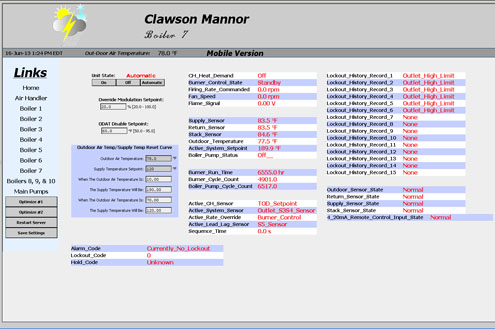
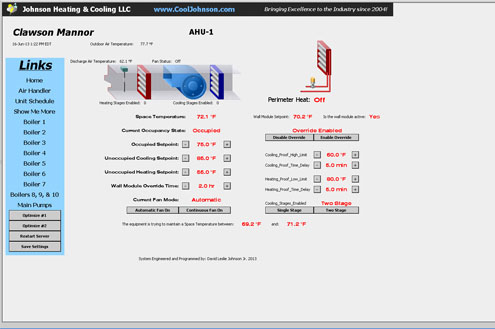
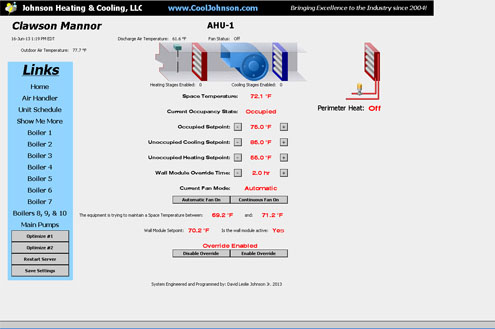
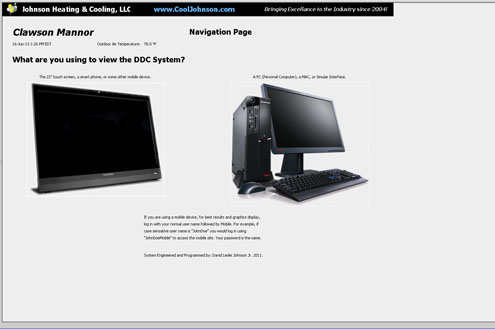
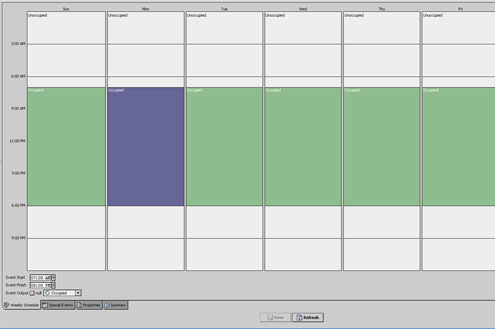
Clawson ManorBuilding Automation
In 2010 Johnson Heating and Cooling L.L.C. was contracted to install a building automation system that would control the mechanical systems for a 17 story high rise near Detroit, Michigan.
BAS PageWhen your workmanship is responsible for keeping a thousand senior citizens warm in the winter, that is a responsibility that should always be taken seriously. The men and woman at Johnson Heating and Cooling, LLC, and Johnson Engineering, Inc. are no strangers at providing "high stakes" services to our customers. We have an extensive background doing work that is not for the faint of heart. We have built and serviced high pressure boiler systems used to produce high explosives, done a lot of work at medical buildings and hospitals, and have designed, engineered, programmed, and installed building automation systems on projects like Clawson Manor, where robust system design, equipment failure alarming, and safety are of the upmost importance. "I tell the guys that I work with to move quickly when preparing to work, but then to take their time when doing critical or dangerous work. Moving too fast in this industry can be very costly, and most importantly, moving to fast can be dangerous to the technician and to others" David Johnson Jr.- Owner of Johnson Heating and Cooling, LLC. Johnson Heating and Cooling, LLC only employs very talented individuals who are considerate of the customer at all times. We are very good and speedy at our profession, but we never jeopardize safety to get the job done a few minutes earlier, and we never take "short-cuts" that might have significant detrimental effects on the robustness of our customers equipment.
In 2010 Johnson Heating and Cooling, LLC was contracted to design, engineer, program, install and tune a building automation system at a seventeen story senior housing building located in Clawson, Michigan. Johnson Heating and Cooling, LLC facilitated Johnson Thermol Temp, inc in the selection and installation of seven heating boilers and three domestic hot water boilers. Johnson Heating and Cooling, LLC installed miles of wire and hundreds of feet of conduit, one server, five variable frequency drives, many relays, many sensors, input / output modules, a Honeywell controller, a Honeywell wall module, pressure transducers, a switch, a router, a control cabinet, and three different types of communication networks, each utilizing a different protocol, which where all integrated into one building automation system. The amount of wire used to construct the building automation system was quite mind-blowing, especially considering the size of the mechanical room. The system was designed and installed to be robust - first and foremost. Because hard wiring devices is the most dependable solution for communication lines and sensor value transmission, that is what Johnson Heating and Cooling, LLC did.
The building automation system at Clawson Manor was installed to achieve several purposes. Firstly, and probably most obviously, the system was installed to reduce energy consumption. The old "control system" at Clawson Manor consisted of a boiler stager with outdoor air temperature reset and no circulating pump control at all, except for a disconnect to turn the pumps off in the summer and on in the winter. Nearly every controls contractor and most boiler makers might come to the conclusion, "well, if the boilers have an outdoor reset with staging, there is not much more that can be done to increase efficientcy of the boilers. As for the pumps, putting them on variable frequency drives will save some money". The thing that the typical controls contractor or boiler maker would be missing is the impact that delta T has on efficientcy. Delta T is the difference in temperature between the return water temperature and the supply water temperature of the boilers. Think about it this way; if the inlet water temperature of a boiler is lowered, the stack temperature of the boiler will also be lowered, thus there will be higher efficientcy because the air leaving the structure is cooler. Most boiler makers and nearly every single controls contractor would miss this important fact. Johnson Heating and Cooling, LLC programmed the variable frequency drives that circulate the water throughout the building to not only run at reduced rates to conserve electricity, but to also conserve gas. In fact, when writing the control program for the pumps, electrical savings where all but ignored because gas consumption reduction calculations would, inadvertently be the absolute lowest running speed that the motors could function at while still providing adequate heating to the structure. The idea is to always provide enough water movement to provide heat to the building, but to reduce the flow of water so that the water temperature coming back to the boiler room would be lower. Based on the heat loss calculations of the building, the manufacturer's specifications on the greatest possible delta T (which was not to exceed 40 degrees F), and days of program tuning, we developed code that operated the equipment so that the customer saved an additional 5% or so on their gas bills. The 5% savings was above and beyond any other building automation system savings and is only specific to the delta T consideration in the code. The total savings due to the building automation system resulted in a savings of around 20% in energy costs alone.
Obviously, outdoor air temperature reset was included in the code that controls the boilers. Outdoor air temperature reset reduces the discharge water temperature set point of the boilers as the outdoor air temperature increases, because, as noted above, the lower the stack temperature, the more efficiently the boiler is operating. We programmed and tuned the system with a natural heat anticipation function. Because of the thermal mass of the building, the "heat anticipator" function of the program occurred naturally. The system is designed to shut down the boilers exactly when they need to be shut down, and turn on the boilers exactly when they need to be turned on. A percent here and there in efficientcy loss adds up over a decade or so, so we took the time to get it right the first time so that our customer would save money.
The installation and integration of variable frequency drives lowered the energy consumption of the building's circulation pumps to about 15% of what they had been using before. If that sounds hard to believe, I'll explain, and we can do the math. A variable frequency drive functions by modulating the frequency of the electricity provided to the motor that it powers. In the USA, the electrical grid uses a frequency of 60 Hertz or 60 cycles per second. Variable frequency drives are able to decrease the output and energy consumption of motors by lowering the frequency of the electricity provided to the motor, however the relationship between motor output and energy consumption is not a linear one. If the variable frequency drive provides electricity to the motor at 30 Hertz, the output of the motor will be 50% because 30 Hertz divided by 60 Hertz is 0.5 or 50%. The energy consumption of a motor running at 50% or 30 Hertz will not be 50%, but will instead be something like 18% because the relationship between motor output and energy consumption are not linear. The exact ratios of motor output or Hertz provided to the motor (which are effectively the same thing), and the actual energy consumption of the variable frequency drive / motor combination depend on the efficientcy of the variable frequency drive. For example, because the variable frequency drive needs power itself to communicate with the building automation system, run it's cooling fan, etc, if the motor always ran at 100% with the variable frequency drive installed the cost of operation or electricity consumption would actually go up with the new variable frequency drive installed. The amount of energy that variable frequency drives consume is nominal and is hardly worth consideration when calculating savings, however it did need to be noted that VFD's do consume energy themselves. Due to the fact that the variable frequency drives rarely ever run at 100% and spend most of their time in the 40% output range, and the fact that now the pumps completely shut down when not needed, the variable frequency drives have reduced the energy consumption of the pumps to around 15% of what they had been using before.
In addition to the variable frequency drives greatly reducing the energy consumption of the pumps and allowing the boilers to function more efficiently, the variable frequency drives also increased the life span of the motors and allowed for easy system alarming in the event of pump or variable frequency drive failure. It's pretty obvious to anyone who has ever worked on or driven an old car that jumping on the gas petal is a recipe for disaster. Pump motors are much like old engines in the sense that pushing them at 100% for extended periods of time increases the rate of failure. Running a motor at a reduced rate will be easier on both the motor bearings and the motor windings. As far as the alarming is concerned, if either a pump motor fails, or the variable frequency drive that controls it fails, we have provision for knowing about the failure right away before the building is cold.
Redundancy! It's a good thing to have job security, but not when it comes at the expense of others, and when you design, engineer, or install something in such a way that you are the only person who can work on that job, I think that then God's sense of humor comes into play. Our work is complicated enough without trying to over complicate things, and there are many parts of a building automation system that can cause the system to fail. We designed the building automation system at Clawson Manor to be as user friendly and as redundant as possible. With multiple safeguards that ensure safe, continued operation in the event of one of the "links in the chain" breaking, our customers can rest assured that their heating and cooling systems are not "swinging by a shoe lace", and that is especially true at Clawson Manor.
Another way in which we saved our customer money is by using the "sweet spot" on the boiler's firing rate. Most controls contractors would program the building automation system to fire the boilers 0-100%, and then start the next boiler once the previous boiler hit 100%. We did not write code to control the boilers in this way because boilers running at 100% are not as efficient as boilers running at say, 45%. We developed custom code that utilizes the absolute most efficient firing rate of that boiler's model. The end result is only a few percentage gain in efficiency, however, every bit matters, and our customers hire us because of quality workmanship, honesty, and coempetitive pricing, and not just because we are the "low bidder". When it comes to writing code, the customer usually doesn't know the difference between a great job and a poor job, but the difference can have a huge impact on the bottom line for years to come. When you call Johnson Heating and Cooling, LLC, you can deal directly with the owner, and our reputation means a lot to us. We have lost jobs because we are not willing to provide our potential customers with a building automation system that we can not put our name too. When you hire Johnson Heating and Cooling, LLC for your building automation system work, you can rest assured that you will get an excellent job that we will be proud to put our name on.